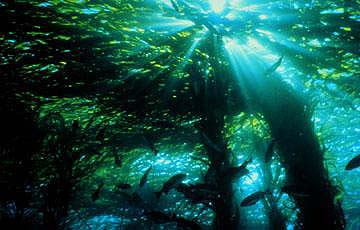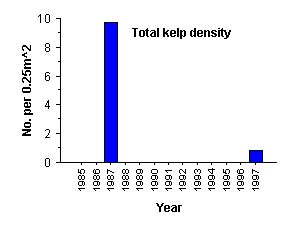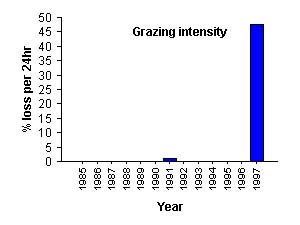 |
| back
to data |
|
 |
| Photo
courtesy of UCSC |
|
Many
fish species, like herring, rely on the kelp as a surface for their larvae
to use as settlement habitat. Meanwhile adult fish feed and hide in the
kelp fronds.
Invertebrates
such as crabs, snails, bryozoans, ascidians, sea urchins, clams, and shrimp
are also found in kelp forests. Some use the blades as living habitat,
while others feed on the kelp itself.
Sea otters
also find safety and food in kelp forests. They feed on the sea urchins,
clams, and crabs that live in this undersea forest. The long stands of
kelp provide good protection from predators.
Humans have
also begun to commercially harvest kelp. Kelp can be processed into nutritional
supplements for direct human consumption, or into fertilizer
(
www.biology.ucsc.edu/people/raimondi/readdie/ecology.htm)
|
| Tall
stands of giant kelp attach to rocky substrate to form dense forests that
create a three-dimensional habitat. The ocean is truly a 3-D world where
there are no hiding places. An animal swimming in the water column can be
attacked from every direction. Kelp forests offer a haven for protection
as well as hard surface for settlement. |
| Sea
otters and sea urchins in the kelp forest. |
|
Sea urchins
are voracious herbivores. They climb up the holdfast and graze on the
stipe, as well as eat drift algae that accumulate on the ocean bottom.
Studies have found urchins responsible for completely removing kelp from
an area, leaving it an urchin barren. Sea otters feed primarily on sea
urchins, and thus are an important predator in the kelp forest. Aleutian
Islands that have been recolonized by sea otters now have thriving kelp
forests where extensive urchin barrens once dominated.
(www.biology.ucsc.edu/people/raimondi/readdie/ecology.htm;
Estes and Palmisano, 1974)
|
|
|
| Figure
1. Picture of an urchin barren. Purple and red sea urchins cover
most of the outcropping. Only a few stipes and stands of kelp
remain. |
|
|
| |
|
|
| Figure
1. Total kelp density around Adak Island in 1987 and 1997. |
|
|
|
|
| Figure
2. Grazing intensity as measured by percent kelp loss per day
around Adak Island in 1991 and 1997. |
|
|
|
This study
surveyed kelp forest density and sea urchin biomass at Adak Island. The
graphs contrast the changes in kelp density and urchin biomass during
a ten year period (1987 - 1997):
- Kelp density
declined by a factor of 12 (Figure 1).
- Average
rate of kelp tissue loss to herbivory increased from 1.1% per day in
1991 to 47.5% per day in 1997 (Figure 2).
- Sea urchin
size and density produced an eight-fold increase in biomass (Figure
3).
- Notice
the time frame correlation between the kelp forest degradations and
sea otter decline.
- What
is happening to the kelp forest as a result of the declining sea otter
population?
(Figures
modified from data presented in Estes et al, 1998)
|
|
|
| Figure
3. Sea urchin biomass around Adak Island in 1987 and 1997. |
|
|
| back
to data |
|
| |
|
This web
site was created by Lynn Tran at the North Carolina State University, Department
of Mathematics, Science, and Technology Education on 7/12/03. Faculty advisor
Dr. David Eggleston, NCSU, Department of Marine, Earth, & Atmospheric Sciences.
Last updated
December 29, 2003
.
|




